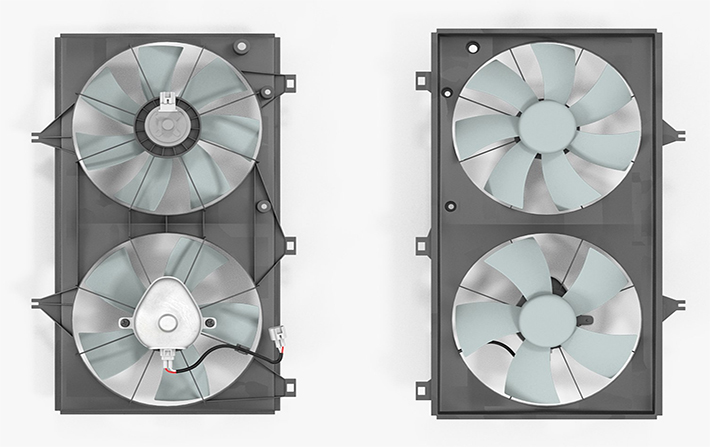How does a car radiator fan work?
2025-03-07
The automobile radiator fan is an important part of the cooling system, and its main role is to enhance the heat dissipation effect of the radiator through forced ventilation to ensure that the engine works at a suitable temperature. This paper will deeply discuss the working principle, types and common faults of automotive radiator fans.

Working principle of radiator fan
Automotive radiator fans are usually installed behind the radiator, and their working principle is relatively simple but crucial:
1. Temperature sensing: When the engine temperature rises to a certain degree, the temperature sensor will transmit the signal to the electronic control unit (ECU).
2. Signal processing: The ECU determines whether to start the fan based on the received temperature signal.
3. Fan start: If it is necessary to cool down, the ECU sends a signal to the fan motor to start the fan.
4. Forced ventilation: Fan rotation generates airflow, accelerates air through the radiator, takes away heat, and reduces the coolant temperature.
5. Temperature control: When the engine temperature drops below the set value, the ECU will stop the fan operation.
Type of radiator fan
According to the different driving methods, automotive radiator fans are mainly divided into the following two types:
1. Mechanical fan: driven by the engine crankshaft through the belt, the fan speed is proportional to the engine speed. Mechanical fans have a simple structure and low cost, but their efficiency is relatively low and will increase the engine load.
2. Electric fan: driven by motor, speed is controlled by ECU according to engine temperature. Electric fans have high efficiency, low noise, and can adjust the speed according to needs, but the structure is relatively complex and the cost is high.
Common faults of the radiator fan
The failure of the radiator fan will cause the engine to overheat and affect the normal running of the vehicle. The following are some common fault symptoms:
1. The fan does not turn: It may be caused by a blown fuse, relay failure, motor damage or line problems.
2. Constant fan rotation: The fault may be caused by the fault of the temperature sensor, ECU, or short circuit.
3. Abnormal fan noise: It may be caused by fan blade deformation, bearing wear or foreign matter stuck.
Maintenance of radiator fan
In order to ensure the normal operation of the radiator fan, it is recommended to perform the following maintenance regularly:
1. Check the operation of the fan: start the engine regularly and observe whether the fan runs normally.
2. Clean the fan blades: Periodically clean dust and debris on the fan blades to prevent heat dissipation.
3. Check the cable connection: Periodically check whether the fan cable is securely connected to avoid faults caused by poor contact.
Summary
The automobile radiator fan is an important part of the cooling system, and its working principle is simple but vital. Understanding the working principle, types and common faults of radiator fans can help us better maintain and use the car, ensure that the engine works at the right temperature, and extend the service life of the vehicle.